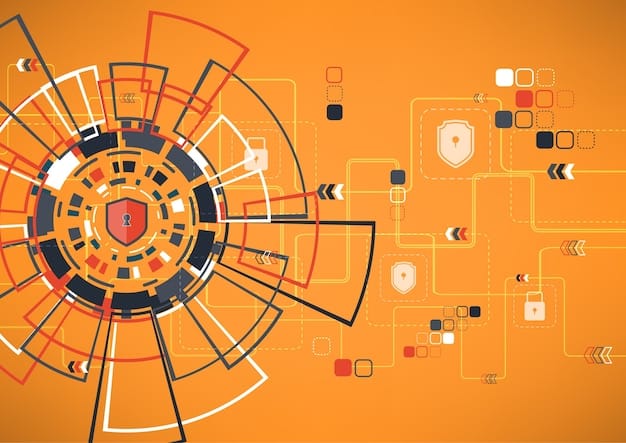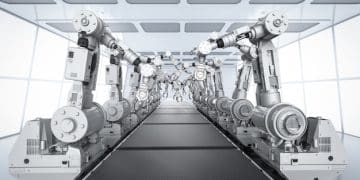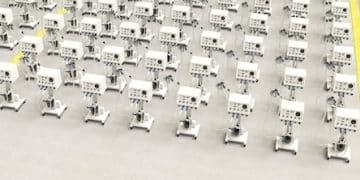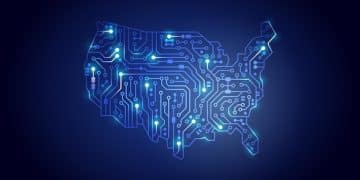US Robotics and Cybersecurity: Safeguarding Robots from Hacking
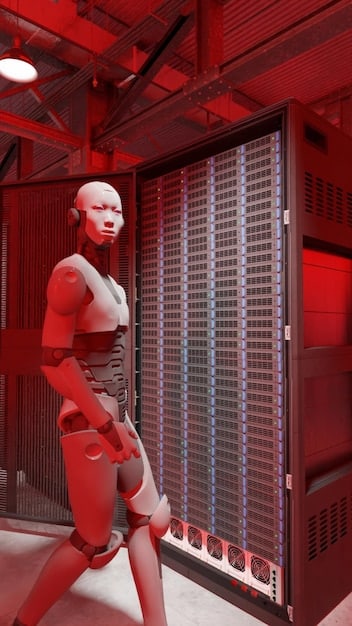
The convergence of robotics and cybersecurity in the US is critical, as safeguarding robotic systems from hacking and data breaches ensures operational integrity, data privacy, and national security in an increasingly automated world.
The rapid advancement of robotics in the United States brings forth unprecedented opportunities, but it also introduces complex security challenges. As robots become more integrated into critical infrastructure, industries, and even daily life, the imperative to protect these sophisticated systems from malicious attacks intensifies. Understanding the intricate landscape of US Robotics and Cybersecurity: Protecting Robots from Hacking and Data Breaches is no longer a niche concern for engineers, but a fundamental pillar for ensuring innovation, public trust, and national security in the 21st century.
The Evolving Landscape of Robotics in the US
Robotics technology in the United States is experiencing a period of explosive growth and diversification, moving far beyond its traditional industrial applications. From automated warehouses and surgical assistants to autonomous vehicles and defense systems, robots are redefining how we work, live, and interact with the physical world. This expansion, while promising immense economic and social benefits, simultaneously broadens the attack surface for cyber threats.
The ubiquity of these machines means that vulnerabilities in their software, hardware, or communication channels could have cascading effects, impacting everything from supply chains to healthcare delivery. The shift from isolated, purpose-built robots to networked, interconnected systems is a major factor amplifying these security concerns. As they communicate with each other, with human operators, and with cloud-based services, each connection point represents a potential entry for cyber attackers.
Industrial and Beyond: Where Robots Are Deployed
The industrial sector traditionally dominated robotic adoption, with arms automating manufacturing processes. Today, however, their reach extends significantly:
- Manufacturing and Logistics: Robots handle assembly, quality control, and inventory, forming the backbone of modern factories and fulfillment centers.
- Healthcare: Surgical robots, remote presence robots, and automated lab assistants are enhancing precision and efficiency in medical environments.
- Agriculture: Autonomous tractors, harvesters, and crop monitoring drones are revolutionizing farming practices.
- Defense and Public Safety: Unmanned aerial vehicles (UAVs), ground vehicles (UGVs), and specialized robots are used for reconnaissance, bomb disposal, and hazardous material handling.
Each application presents unique cybersecurity challenges, demanding tailored defense strategies. A breach in a medical robot, for instance, could lead to patient harm or compromise sensitive health data, whereas an attack on an agricultural robot might disrupt food supply chains.
The increasing complexity of robotic systems, often involving artificial intelligence and machine learning, also introduces new security paradigms. These systems rely on vast amounts of data for decision-making, making the integrity and confidentiality of that data paramount. Protecting against data poisoning or adversarial attacks that manipulate AI models is becoming as critical as safeguarding against traditional malware.
Understanding the Cybersecurity Threats to Robotic Systems
The complex interplay of hardware, software, and network connectivity in robotic systems creates a rich target environment for cyber adversaries. Unlike traditional IT systems, a successful attack on a robot can have tangible physical consequences, ranging from operational disruption to physical damage or even harm to human operators. The motivations for such attacks are diverse, spanning from industrial espionage and sabotage to financial gain and national state-sponsored activities.
One primary concern is the potential for manipulation of robotic movements or functions. Imagine an industrial robot designed to perform precision welding being subtly reprogrammed to introduce flaws in products, leading to massive financial losses and reputational damage. Similarly, an autonomous vehicle could be tricked into deviating from its path, causing accidents or traffic chaos. These physical threats underscore the critical need for robust cybersecurity measures that address both logical and physical security.
Another significant vulnerability lies in the supply chain of robotic components. As robots are often assembled from parts and software libraries developed by multiple vendors, a compromise at any stage of this chain can introduce backdoors or weaknesses that are difficult to detect. This complex ecosystem necessitates comprehensive vetting and continuous monitoring of all components, from embedded systems to operational software.
Common Attack Vectors and Their Consequences
Robots can be targeted through various vectors, each with distinct potential consequences:
- Network Attacks: Exploiting vulnerabilities in communication protocols (e.g., Wi-Fi, Ethernet) or network infrastructure used by robots. Consequences include remote control, data interception, or denial of service.
- Software Exploits: Targeting weaknesses in the robot’s operating system, control software, or embedded firmware. This can lead to unauthorized access, malicious reprogramming, or data theft.
- Hardware Tampering: Physical modification of components to insert malicious chips or alter behavior. Often harder to detect without physical inspection.
- Data Breaches: Exfiltrating sensitive data collected by robots (e.g., environmental scans, facial recognition data, production metrics). This can lead to privacy violations or industrial espionage.
- Supply Chain Attacks: Introducing malware or hardware backdoors during the manufacturing or distribution process of robotic components.
The implications of these attacks extend beyond immediate operational disruption. A data breach involving robots in sensitive environments, such as defense or healthcare, could have severe national security or privacy repercussions. The ability to manipulate robotic sensors, for example, could lead to false information being fed into decision-making algorithms, causing dangerous miscalculations.
Cyber-physical systems like robots require a holistic security approach that integrates IT security principles with operational technology (OT) security paradigms. This means not only protecting the data and networks but also ensuring the physical safety and integrity of the machines themselves and their interactions with the real world.
Regulatory Frameworks and Initiatives in the US
Recognizing the growing importance of cybersecurity for robotics, the United States has initiated several regulatory and programmatic efforts to bolster the security posture of these systems. While there isn’t a single overarching “robot cybersecurity law,” existing cybersecurity frameworks are being adapted, and new guidelines are emerging to address the unique challenges presented by integrated cyber-physical systems. These efforts aim to foster a secure environment for innovation while protecting critical infrastructure and consumer data.
The National Institute of Standards and Technology (NIST) plays a pivotal role in this space. NIST frameworks, such as the Cybersecurity Framework (CSF), provide voluntary guidance to organizations on how to manage and reduce cybersecurity risks. While not specific to robotics, the CSF’s core functions—Identify, Protect, Detect, Respond, Recover—are highly applicable to securing robotic systems. NIST also produces special publications and guidelines relevant to industrial control systems (ICS) and IoT devices, which often encompass robotic technologies.

Key Cybersecurity Guidelines and Standards
Several organizations and government bodies contribute to the cybersecurity regulatory landscape for robotics:
- NIST Cybersecurity Framework (CSF): Provides a flexible framework for organizationsto manage and reduce cybersecurity risks, adaptable for robotic systems.
- Department of Homeland Security (DHS): Focuses on critical infrastructure protection, which increasingly involves robotic systems. DHS offers resources and guidance for securing industrial control systems.
- National Defense Authorization Act (NDAA): Contains provisions related to cybersecurity for defense systems, including those involving robotics, aiming to prevent the use of compromised foreign technology.
- Industry-Specific Regulations: Sectors like healthcare (HIPAA) and finance have specific data privacy and security regulations that indirectly impact robots handling sensitive information.
Beyond these, various industry consortia and academic institutions are working on developing specialized standards and best practices for robotic security, addressing issues like secure software development lifecycles, robust authentication mechanisms for robot-to-robot communication, and the secure integration of AI components. The goal is often a “security by design” philosophy, where cybersecurity is considered from the initial stages of robot conceptualization and development, rather than being an afterthought.
The US government also encourages public-private partnerships to share threat intelligence and best practices, recognizing that securing robotics is a collective responsibility. Conferences, workshops, and research initiatives are continually fostering dialogue and collaboration among industry, academia, and government to stay ahead of evolving cyber threats in the robotics domain.
Best Practices for Protecting Robotic Systems
Implementing a comprehensive cybersecurity strategy for robotic systems requires a multifaceted approach that addresses vulnerabilities across hardware, software, and network layers. It goes beyond simple firewalls and antivirus, encompassing the entire lifecycle of the robot, from design and deployment to operation and eventual decommission. The objective is to build resilience against known threats while also anticipating and adapting to emerging attack vectors, ensuring continuous operation and data integrity.
One fundamental aspect is adopting a “zero trust” security model, where no entity, whether inside or outside the network perimeter, is inherently trusted. This means verifying everything and continuously monitoring for suspicious activity. For robots, this translates to strict authentication for all communications, rigorous access controls for software and hardware, and encryption of data both in transit and at rest.
Regular security audits and penetration testing are also vital. These practices help identify weaknesses before malicious actors can exploit them. Employing ethical hackers to simulate real-world attacks provides valuable insights into potential breach points and allows organizations to fortify their defenses proactively. Furthermore, maintaining an up-to-date inventory of all robotic assets and their software versions is crucial for effective patch management and vulnerability response.
Key Strategies for Robust Robotic Cybersecurity
Effective protection hinges on several critical practices:
- Secure Boot and Firmware: Ensure robots boot from a trusted source, and their firmware is signed and verified to prevent malicious modifications.
- Network Segmentation: Isolate robots from the broader IT network, creating distinct zones for different types of robots or operations to limit lateral movement of attackers.
- Strong Authentication and Access Control: Implement robust multi-factor authentication for operators and systems accessing robots. Apply the principle of least privilege, granting only necessary access rights.
- Software Updates and Patch Management: Regularly update robot operating systems, applications, and firmware to address known vulnerabilities promptly.
- Data Encryption: Encrypt all sensitive data stored on or transmitted by robots, including sensor data, operational logs, and PII.
- Physical Security: Protect robots from physical tampering through secure enclosures, locks, and surveillance, especially for critical systems.
Beyond technical measures, establishing clear incident response plans is paramount. Organizations must have protocols in place to detect, contain, eradicate, and recover from cybersecurity incidents swiftly. This includes having trained personnel, communication strategies, and forensic capabilities to analyze breaches and prevent recurrences. Educating employees and operators about cybersecurity best practices is also critical, as human error often remains a significant vulnerability.
Ultimately, a holistic cybersecurity strategy for robotics is about managing risk. It involves a continuous cycle of assessment, protection, detection, response, and recovery, adapting to the dynamic threat landscape and ensuring that the benefits of robotic innovation are realized safely and securely.
The Role of AI and Machine Learning in Robotic Security
Artificial Intelligence (AI) and Machine Learning (ML) are not just components *within* advanced robotic systems; they are increasingly crucial tools *for* enhancing their cybersecurity. The immense processing power and pattern recognition capabilities of AI/ML enable proactive threat detection, anomaly identification, and sophisticated response mechanisms that would be impossible with traditional rule-based security systems. This synergy positions AI/ML as both a potential vulnerability and a powerful defender in the evolving landscape of robotic security.
One significant application of AI in cybersecurity for robots is in behavioral analytics. By learning the normal operational patterns and communication behaviors of a robot, AI algorithms can quickly identify deviations that might indicate a cyberattack. For example, if a robot suddenly attempts to access an unusual network resource or initiates an uncharacteristic movement sequence, an AI-powered monitoring system can flag this as suspicious activity, triggering an alert or automated response.
Furthermore, AI can accelerate threat intelligence. ML models can rapidly analyze vast quantities of data from various sources—including public threat feeds, vulnerability databases, and internal network logs—to identify emerging threats and potential attack vectors relevant to robotic systems. This allows organizations to implement predictive security measures and strengthen their defenses against novel forms of cyber attacks.
AI-Powered Security Solutions for Robots
AI and ML offer several distinct advantages in protecting robotic systems:
- Anomaly Detection: AI models can establish a baseline of normal robot behavior (e.g., movement, power consumption, data flow) and flag any significant deviations as potential security incidents.
- Predictive Analytics: By analyzing historical attack data and threat trends, AI can predict potential vulnerabilities in robotic systems and recommend preventative measures.
- Automated Incident Response: AI can analyze the scope of an attack and initiate automated responses, such as isolating compromised robots, applying patches, or alerting human operators.
- Malware Detection and Forensics: ML algorithms can identify new and polymorphic malware strains that might evade traditional signature-based detection, and assist in post-incident forensic analysis.
- Vulnerability Management: AI can help prioritize and manage patches by assessing the potential impact of vulnerabilities on specific robotic configurations.
Despite their immense potential, deploying AI securely in cybersecurity contexts also presents its own challenges. Adversarial AI attacks, where malicious actors subtly manipulate inputs to fool AI models, are a growing concern. Therefore, AI-driven security systems themselves must be robustly secured and regularly updated to counter these sophisticated techniques. The continuous learning and adaptation of AI models are key to staying ahead of the equally adaptive cyber threats targeting robotic systems.
The integration of AI into robotic cybersecurity is not merely an enhancement; it’s becoming a necessity. As robots grow in complexity and autonomy, and as the volume and sophistication of cyber threats escalate, AI provides the scalable, intelligent defenses required to maintain the integrity and safety of these crucial technologies.
Challenges and Future Outlook for US Robotics Cybersecurity
Despite significant advancements in securing robotic systems, the landscape of US robotics cybersecurity is fraught with persistent and evolving challenges. The very nature of robotic innovation—rapid development cycles, increasing autonomy, and deeper integration into real-world environments—creates a moving target for security professionals. Looking ahead, addressing these challenges will require continuous adaptation, robust investment, and innovative interdisciplinary collaboration to ensure the safe and reliable deployment of future robotic technologies.
One major challenge lies in the inherent complexity and heterogeneity of robotic ecosystems. Robots are often composed of diverse hardware components from various manufacturers, running on different operating systems and utilizing a multitude of software frameworks. This fragmentation makes it difficult to implement standardized security measures and to ensure consistent patch management across an entire fleet of robots. The lack of universal security standards across the industry further exacerbates this issue, leading to disparate levels of security implementation.
The increasing autonomy of robots also introduces a new layer of security concerns. As robots make more independent decisions, the potential for malicious inputs or manipulated data to lead to unintended or dangerous actions grows. Verifying the integrity of sensor data, securing decision-making algorithms, and ensuring robust fail-safes are critical, yet complex, endeavors. Furthermore, the insider threat, whether intentional or accidental, poses a significant risk, as privileged access to robotic control systems could be exploited.
Emerging Threats and Research Frontiers
The future of robotic cybersecurity will likely contend with:
- Deepfake and Adversarial AI: Manipulating sensor data or AI models to trick robots into misinterpreting their environment or executing erroneous commands.
- Quantum Computing Threats: The long-term threat of quantum computers breaking current encryption standards, requiring the development of post-quantum cryptography for robotic communications.
- Swarm Robotics Attacks: Coordinated attacks on groups of interconnected robots,
aiming to disrupt large-scale operations or create widespread chaos. - Ethical Hacking for Robots: The need for more specialized ethical hackers trained to identify unique vulnerabilities in cyber-physical robotic systems.
- Standardization and Regulation: The ongoing effort to develop and enforce global cybersecurity standards specifically for robotics, promoting interoperability and security by design.
Research efforts are increasingly focusing on resilience engineering for robotic systems, aimed at building robots that can sustain attacks and continue to operate, or fail gracefully, without causing harm. This includes developing self-healing capabilities, redundant systems, and advanced intrusion detection mechanisms tailored for real-time robotic operations. The integration of blockchain technology for secure data logging and integrity verification is also an area of active exploration.
The future successful deployment of robotics hinges on how effectively the US can solve its cybersecurity challenges. This will require not only technological solutions but also a strong emphasis on education, training, and policy development to create a robust and secure robotic ecosystem. Collaboration between government, industry, and academia is vital to stay ahead of sophisticated threats and unlock the full potential of robotics responsibly.
Cultivating a Culture of Cyber-Awareness in Robotics
Technology alone, no matter how advanced, cannot fully secure robotic systems without a parallel commitment to human awareness and organizational culture. A robust cybersecurity posture for robotics hinges significantly on cultivating a deep-seated culture of cyber-awareness among all stakeholders—from engineers designing the robots to operators interacting with them daily. This human element is often the weakest link in the security chain, and addressing it requires continuous education, clear policies, and a proactive approach to risk management.
In many instances, security breaches are not due to sophisticated zero-day exploits, but rather to basic human errors: forgotten passwords, clicking on phishing links, or a lack of understanding regarding secure operational procedures. For robotic systems, this translates to mishandling access credentials, connecting robots to unsecure networks, or failing to report unusual operational anomalies that could signal a cyberattack. Therefore, empowering every individual involved with robotic systems with cybersecurity knowledge is a critical defensive measure.
Establishing clear lines of responsibility for cybersecurity within an organization is also paramount. Rather than relegating it solely to IT departments, cybersecurity for robots must be a shared responsibility, integrating security considerations into engineering, operations, and management workflows. This involves regular training sessions, simulated phishing exercises, and an open environment where employees feel comfortable reporting potential security concerns without fear of reprisal.
Key Elements of a Cyber-Aware Robotics Culture
Building a strong cyber-aware culture involves:
- Regular Training Programs: Conduct ongoing education for all personnel—developers, engineers, operators, and maintenance staff—on the latest cybersecurity threats specific to robotics.
- Security by Design Principles: Instill a mindset where cybersecurity is factored into every stage of robot design, development, and deployment, not as an afterthought.
- Clear Policies and Procedures: Establish comprehensive, easy-to-understand guidelines for secure robot operation, data handling, password management, and incident reporting.
- Promoting a Reporting Culture: Encourage employees to report suspicious activities, anomalous robot behaviors, or potential vulnerabilities without hesitation.
- Leadership Buy-in: Ensure that cybersecurity is prioritized at the highest levels of management, demonstrating commitment through resource allocation and active participation in security initiatives.
Beyond formal training, fostering a continuous learning environment is essential. This can include sharing industry best practices, circulating articles on recent cyber incidents affecting robotics, and encouraging participation in cybersecurity workshops or forums. The objective is to make cybersecurity a natural part of daily operations, akin to safety protocols in any hazardous environment.
Ultimately, a robust cybersecurity culture for robotics is about building a collective understanding that security is not just a technical problem but a human responsibility. By prioritizing awareness, education, and proactive engagement, organizations can significantly reduce their risk exposure and ensure that the powerful capabilities of robotics are harnessed safely and ethically for the benefit of society.
| Key Aspect | Brief Description |
|---|---|
| ⚙️ Evolving Risks | Robots’ expanded roles introduce new vulnerabilities and attack surfaces, demanding constant security adaptation. |
| 🔒 Threat Vectors | Network, software, hardware, and supply chain attacks pose significant risks, leading to data breaches or physical harm. |
| 🛡️ Best Practices | Secure boot, network segmentation, strong authentication, and regular updates are crucial for robotic system protection. |
| 🧠 AI’s Role | AI and ML are vital for anomaly detection, predictive analytics, and automated incident response in robotic cybersecurity. |
Frequently Asked Questions About Robotics Cybersecurity
▼
Cybersecurity for robots is critical because attacks can have tangible physical consequences, unlike typical IT systems. Breaches can lead to operational disruption, physical damage, safety hazards for humans, and compromise of critical infrastructure or sensitive data, escalating the impact beyond mere data theft or system downtime.
▼
The main threats include network attacks (exploiting communication vulnerabilities), software exploits (targeting operating systems or control software), hardware tampering (physical component modification), data breaches (exfiltrating sensor or operational data), and supply chain attacks (injecting malware during manufacturing). These can lead to unauthorized control, data theft, or physical manipulation.
▼
The US government addresses robotic cybersecurity primarily through frameworks and guidelines from NIST, such as the Cybersecurity Framework, which are adaptable for robotics. Additionally, agencies like DHS focus on critical infrastructure protection, and the NDAA contains provisions for defense systems. Public-private partnerships are also encouraged to share threat intelligence and best practices.
▼
“Security by design” for robotics means integrating cybersecurity considerations from the very initial stages of a robot’s conceptualization and development, rather than adding them as an afterthought. This ensures that security measures are built into the fundamental architecture, hardware, and software, making the system inherently more resilient to attacks.
▼
Yes, AI and Machine Learning are powerful tools for robotic cybersecurity. They can enable advanced anomaly detection by learning normal robot behavior, allowing for rapid identification of suspicious activities. AI also aids in predictive analytics for identifying future vulnerabilities and can facilitate automated incident response, making defenses more proactive and efficient.
Conclusion
The integration of robotics into virtually every facet of American life underscores both a promise of unparalleled advancement and a profound responsibility to ensure their security. The journey to protecting robots from hacking and data breaches is intricate, demanding constant vigilance from developers, operators, and policymakers alike. As cyber threats become more sophisticated, the emphasis must shift towards a holistic approach that intertwines robust technical safeguards with an unyielding commitment to cyber-awareness at every organizational level. The future of US robotics, and indeed its broader technological sovereignty, hinges on our collective ability to anticipate, adapt, and build resilient systems capable of withstanding the evolving landscape of digital adversaries, ensuring that innovation flourishes in a secure and trustworthy environment.
